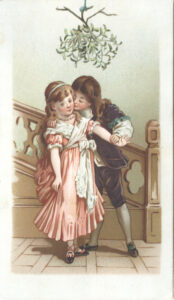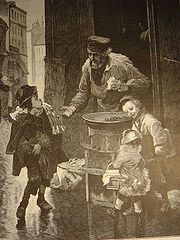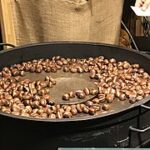
A series on Christmas greenery isn’t complete without mistletoe, an Anglo-Saxon word that translates as “dung on a stick.” In many ways, mistletoe is a curious symbol of Christmas.
On the one hand, mistletoe is a rootless parasite drawing nutrients from its host tree. On the other, its bright green color contrasts with the leafless branches it lives on. Like other evergreens, mistletoe is an omen of good luck, able to ward off evil spirits and witches. Druids believed mistletoe cured illnesses, and the plant’s white berries were the source of fertility.
Druids harvested mistletoe at night on the sixth day of a waxing moon. The ritual required a meal under the host tree after which two white bulls were brought in. One Druid climbed the tree and cut the mistletoe. The bulls were then sacrificed, and the mistletoe brewed into a drink to restore fertility.

On a lighter note, the English introduced the custom of kissing under mistletoe. One white berry was plucked from the mistletoe sprig for each kiss. Once the berries were gone, the kissing was over. [Sidebar: The girl in this drawing doesn’t look very enthusiastic.]
ROASTED CHESTNUTS
The custom of roasting chestnuts in America relates to the American Chestnut Tree, a deciduous tree once called the finest chestnut tree in the world. American chestnut trees grew to over 100 feet tall and more than 10 feet wide.

The chestnut harvest took place in late fall, and the nuts were one of the most common ingredients in American dishes in the 18th and 19th centuries. Harvesters sent trainloads of chestnuts to Baltimore, Philadelphia, New York, and Boston. Vendors purchased them and sold bags of chestnuts roasted over charcoal. The aroma became associated with the Christmas season.
In 1904 a fungal parasite arrived with a shipment of Japanese nursery stock. By 1940, about 4 billion trees were gone. In the 1950s the tree was declared extinct, though there are efforts to bring it back.
Americans import about $20 million of chestnuts from China, Korea, and Italy. But though the nuts are tasty, they aren’t the ones referred to in
THE CHRISTMAS SONG

Chestnuts roasting on a open fire is the first line of one of the most popular Christmas songs of all time. Mel Torme and Robert Wells wrote the song in 1945 during a long hot summer.
Wells was trying to cool himself off by thinking of things that reminded him of the cold. He doodled a list of items: roasting chestnuts, Jack Frost, Yuletide carols, and folks dressed like Eskimos. Torme saw the notes when he arrived at Wells’ house, and in 45 minutes, the two wrote The Christmas Song.
In 1946, Torme offered the song to Nat King Cole. Executives at Capitol Records initially rejected The Christmas Song, because they didn’t think white Americans would buy a Christmas song sung by an African American. They were wrong.
Cole came out with (I Love You) for Sentimental Reasons. It was a smash hit that broke the musical color line. Fans wanted more. Cole followed up with A Christmas Song in December 1946. He recorded the song two more times in 1953 and 1961. The last recording is still counted among the most popular Christmas songs.
I hope you enjoyed the “Holiday Evergreen Series.” This is my last blog of 2019. I wish you the happiest of holidays and will see you again next year.

Holly & Mistletoe Card. Public Domain.
Children Kiss Under the Mistletoe, Woolson Spice Company. Public Domain.
French Chestnut Vendor, 1881.
English Chestnuts Over an Open Fire in Vienna by Montanabw.
Trevor Dines. “Why We Kiss Under Mistletoe.” BBC. Dec 24, 2015
Becky Little. “How Mistletoe Became Everyone’s Favorite Parasite.” National Geographic. Dec 18, 2015.
Michael Marcucci. “The American Chestnut.” Leaf. July 22, 2015.
Matt Micucci. A Short History of …’the Christmas song’”. Jazziz. Dec. 14, 2018.”

Sandra Wagner-Wright holds the doctoral degree in history and taught women’s and global history at the University of Hawai`i. Sandra travels for her research, most recently to Salem, Massachusetts, the setting of her new Salem Stories series. She also enjoys traveling for new experiences. Recent trips include Antarctica and a river cruise on the Rhine from Amsterdam to Basel.
Sandra particularly likes writing about strong women who make a difference. She lives in Hilo, Hawai`i with her family and writes a blog relating to history, travel, and the idiosyncrasies of life.

